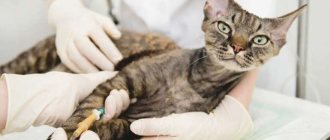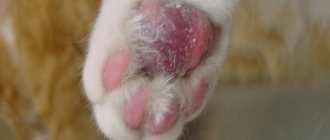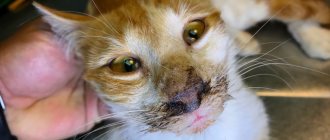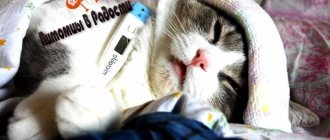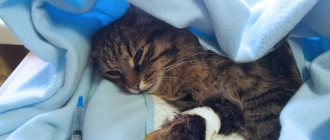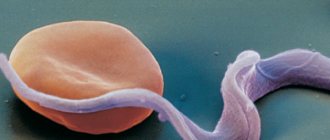Mycoplasmosis, which belongs to the category of infectious diseases that affect the respiratory tract, liver and genitourinary system, is considered a fairly common disease in cats. The pathology is caused by small microorganisms (mycoplasma prokaryotes).
This type of microorganism is not endowed with cell walls and self-reproduces on a cell-free nutrient medium. Against this background, difficulties arise in treating the pet. Mycoplasma prokaryotes are resistant to most antibiotics. Below you can find information regarding the symptoms and treatment of the disease.
Mycoplasmosis: causative agent and course of the disease
Mycoplasmas (a separate type of protozoan) that cause disease in cats are called gatae and felis. A person is more often infected with the hominis strain, but other varieties are also dangerous for him.
Mycoplasmas that have entered the cat’s body actively produce toxins and infect red blood cells. Mycoplasma gatae leads to inflammation of the upper respiratory tract, and mycoplasma felis leads to disruption of the functioning of all internal organs and systems. The genitourinary and skeletal systems are particularly affected.
The main feature of these microorganisms is the absence of cell walls. They can easily change their appearance, complicating diagnosis. Mycoplasmas are also very resistant to some antibiotics, which complicates treatment with most popular drugs. Outside the body, they die under the influence of UV rays, low temperatures and chlorine disinfectants.
Is it contagious?
...for a person?
There is only one answer to this question: feline mycoplasmosis is not transmitted to humans.
Research by various scientists has proven the existence of about 100 species of mycoplasmas. Of these, only 6 are dangerous to humans. They are transmitted from an infected person to a healthy person through sexual contact. And the child becomes infected from the mother in utero or at birth.
…for cats?
Feline mycoplasmas are harmless to the strong immunity of healthy animals. It protects them from infection!
Is it dangerous for pets who are weakened, pregnant, young or over 8 years old?
Answer: dangerous and contagious!
Infected and sick animals are a source of infection for this risk group.
…for dogs?
Dogs and cats have different types of mycoplasma that causes the disease. Therefore, the possibility of them becoming infected from each other is unlikely.
Causes of the disease
It is almost impossible to become infected on the street. The pathogen survives in water and soil for a very short time, so the likelihood of transmitting it to a pet through its own shoes is very low. Most often, animals become infected through direct contact with a sick person.
Sources and routes of infection
Mycoplasma is excreted along with body fluids, so it can be found in saliva, blood, urine, semen and vaginal lubrication. Based on this, the following routes of infection are distinguished:
- Airborne
. The pathogen enters the body by inhaling droplets of mucus released when a sick cat coughs or sneezes.
- Contact
. This group includes cases of infection during mating, games, fights and licking each other.
- Transplacental
. An ill mother passes the infection to her offspring through the placenta or during passage through the birth canal.
- Hemocontact
. An animal becomes infected from a sick donor during a blood transfusion.
Please note that not only direct but also indirect interaction is dangerous. When several pets are kept together, the infection is easily transmitted through common household items: toys, bowls, trays.
At-risk groups
Mycoplasmosis is most acute in kittens. This is explained by weak immunity, unable to fight back the pathogen. Other factors can complicate the course of the disease:
- elderly age;
- presence of chronic diseases.
With age and with relapses of other pathologies, the immune system is greatly depleted. Because of this, adult pets become just as vulnerable as newborn kittens.
Complications
With timely and correct treatment, consequences can be avoided. If the cat is very sick or the pathology occurs against the background of an intense decrease in immunity, complications may develop:
- heart disease: arrhythmia or tachycardia, pericarditis;
- arthritis or arthrosis;
- hepatitis or hepatosis;
- renal failure, nephrosclerosis.
Overt or hidden symptoms
The incubation period is about 10 days. All this time, mycoplasmosis does not manifest itself in any way. The first alarming changes are noted in the animal’s behavior. It becomes lethargic and drowsy, and may also refuse to eat. Gradually, other symptoms reminiscent of a common cold appear:
- sneezing and coughing;
- increased tearfulness and hypersalivation;
- redness and inflammation of the eyes;
- nausea and stool upset;
- increase in body temperature.
When diagnosed at this stage, the disease can be treated fairly quickly.
In other cases, the prognosis is ambiguous. It all depends on the degree of damage to the internal organs. With the loss of their functionality, the existing symptoms are supplemented by more pronounced signs:
- purulent discharge from the eyes;
- hair loss;
- pale gums;
- inflammation of the lymph nodes;
- urinary disturbance;
- joint pain;
- lameness;
- skin ulceration.
Most of the time, a sick pet just lies there. When trying to stand up, he clenches his paws or falls, since the standing position is given to him with great difficulty. All internal systems gradually fail, so at an advanced stage the animal dies from complications.
Symptoms
In the acute form of mycoplasmosis, the incubation period lasts 8-10 days, its symptoms are pronounced. The chronic form is characterized by a sluggish course, a blurry picture, alternating remissions and relapses. Its first symptoms may appear several weeks after infection: mycoplasma is able to introduce its own antigen into the plasma membrane of the cell, after which the animal’s immune system ceases to perceive Mycoplasma as a foreign entity and stops fighting it.
One of the main signs of mycoplasmosis is serous conjunctivitis, in which redness of the conjunctiva of the eyes and profuse lacrimation are observed. Then clinical symptoms such as coughing, sneezing, nasal discharge, increased body temperature to 38-39°, weakness, and refusal to eat appear.
With mycoplasmosis, a cat often sneezes
In mild forms, the disease often goes away on its own, without treatment, within a week. If there is a generalized form of the disease, or a secondary infection occurs, as a result of mycoplasma damage the following may develop:
- purulent conjunctivitis;
- bronchitis;
- pneumonia, pulmonary edema;
- cystitis;
- prostatitis;
- nephritis, pyelonephritis;
- purulent polyarthritis;
- joint erosion;
- skin abscesses;
- animals develop digestive problems;
- Pregnant cats may have miscarriages, and males may lose their ability to reproduce.
Most of the severe complications develop in the absence of adequate treatment. Therefore, if your cat often “gets a cold,” it makes sense to contact a veterinarian and have the animal examined for the presence of mycoplasmas in its body.
Why do you need a veterinarian diagnosis?
After detecting alarming symptoms, your mustachioed pet must be taken to a veterinary clinic. Due to the similarity with colds and other pathologies, independent diagnosis is impossible. At best, attempts at home treatment simply will not yield results; at worst, they will aggravate the patient’s condition.
Diagnosis by a veterinarian involves the following studies:
- analysis of the clinical and biochemical composition of the blood (in the presence of infection, the number of red blood cells is below normal);
- ELISA and PCR, determining the type of pathogen;
- taking smears from the genitals and conjunctiva;
- bacteriological analysis of urine, determining the sensitivity of bacteria to antibiotics.
After confirmation of mycoplasmosis in a cat, the veterinarian selects a treatment regimen. On average, recovery takes 2-3 weeks.
Airborne transmission
Sexually transmitted mycoplasmas are quite insidious and require control. Can this microorganism also spread through airborne droplets?
Yes, if we are talking about a type such as respiratory mycoplasmosis, the causative agent of which is Mycoplasma pneumoniae. Mycoplasmas that are tropic to the urogenital tract cannot be transmitted in this way.
Airborne transmission means coughing, sneezing, talking, that is, any entry of saliva into the environment and penetration through the respiratory tract into the human body.
Mycoplasma of this species can provoke the development of diseases such as pneumonia, bronchitis, pharyngitis, and tracheitis. More often it is diagnosed in outbreaks of epidemics.
When infected, after contact with a carrier of the infection and the manifestation of symptoms, the person remains infectious for ten days of active symptoms. Often the disease can become chronic, which increases the risk of the pathogen being released by airborne droplets into the environment. This period sometimes extends to three months or even longer.
How to treat mycoplasmosis in cats
Drug therapy is based on taking antibiotics, relieving symptoms and increasing immunity. The first improvements are noted after 3-5 days.
Doctor prescribing antibiotics
Most often prescribed are Sumamed, Tetracycline or Doxycycline. These antibiotics help kill the pathogen, but can cause irreversible damage if overdosed. For this reason, you should strictly follow all medical recommendations without changing the amount of the drug or the order of administration.
Antibiotic therapy is especially difficult for kittens and pregnant animals. The negative effects of these drugs are removed with probiotics. In case of severe liver damage, hepatoprotectors may be required.
Pet care
Hospitalization is only necessary for severe anemia. In this case, the animal is given a blood transfusion. If the condition is stable, treatment is carried out at home.
Isolate your pet in a separate room and choose a soft bed for him. Remember that due to the soreness of the joint and bone tissues, it is better not to pick up the cat until he recovers. The same goes for bathing and brushing. Movement around the house should be limited, and walking on the street should be completely canceled.
Gentle diet
In addition to individual supplements, you should also take care of the diet itself. All foods should be nutritious, but easily digestible. It is better to consult a veterinarian about the menu, since if you have diarrhea or constipation, you will need completely different dishes.
It is much easier to switch your pet to ready-made dry or wet food. This type of diet requires drinking a lot of water, so make sure it is fresh and available.
Treatment
Since the most characteristic manifestations of mycoplasmosis in cats are conjunctivitis and rhinitis (inflammation of the outer membrane of the eye and the mucous membrane of the nasal cavity), symptomatic treatment will be aimed at eliminating them. Prescribed washing of the mucous membranes with saline solutions, as well as local antibacterial and anti-inflammatory therapy: eye drops Tsiprolet, Dekta-2, Lacrimin aseptic, Iris, Conjunctivitin, nasal preparations Argumistin, Fosprenil.
To destroy the causative agent of the disease, antibiotics of the tetracycline group, Doxycycline or Levomycetin, which suppress the synthesis of prokaryotes, are most often used. The standard duration of treatment is from 7 to 14 days.
Also used:
- aminoglycosides Gentamicin, Netilmicin, Amikacin;
- fluoroquinolones Ofloxacin, Levofloxacin;
- macrolides Azithromycin, Zithrocin, Clarithromycin, Tylosin.
After a course of antibiotics to restore liver and intestinal function, animals are usually prescribed maintenance therapy. These are hepatoprotectors Divopride, Hepatovet, Vet Expert Hepatiale Forte and probiotic preparations containing beneficial bacteria for the gastrointestinal tract FortiFlora, Pro-Kolin Protexin, Aminosu, Yoguru, Zendakim.
When treating cats for mycoplasmosis, immunostimulants (bioactive substances that activate the immune system) are mandatory: Gamaprene, Immunol, Vet Forvet, Salmozan.
The danger of mycoplasma
If you have dogs, ferrets or other animals living in your home, then you don’t have to worry about their health. Strains gatae and felis affect only the cat family and very rarely cause disturbances in the human genitourinary system.
For cats: complications and risks
The advanced form of the disease is complicated by hepatitis, pneumonia, tachycardia, nephrosis, renal failure, arthritis and arthrosis. Simultaneous infection with several strains of pathogens is especially dangerous.
Pregnant cats are at risk of giving birth to stillborn kittens or becoming infected during childbirth. Regardless of the outcome, the likelihood of babies dying is very high, since immediately after birth the immune system is too weak to fight pathogenic microorganisms.
For humans: probability of infection
Mycoplasmosis in cats poses a serious danger to people with weakened immune systems. The risk group includes:
- children under 3 years old;
- HIV-infected
- people with chronic diseases;
- patients undergoing chemotherapy or who have recently undergone surgery.
The gatae and felis strains are less likely to be infected than the hominis strains. Despite this, veterinarians recommend not hugging, kissing or hand-feeding a sick pet until it recovers. After treatment procedures, as well as cleaning the tray or bowl, you should thoroughly wash your hands with soap or treat them with an antiseptic.
Prevention methods
There are no vaccinations against mycoplasmosis. However, this does not mean that it is impossible to prevent the development of this disease in a pet.
To prevent mycoplasmosis, veterinarians recommend vaccinating the animal against other diseases according to the plan and paying sufficient attention to its immunity, providing it with all the necessary minerals and vitamins.
Although such measures will not protect the cat from this disease, they will significantly reduce the risk of infection from other pets.




